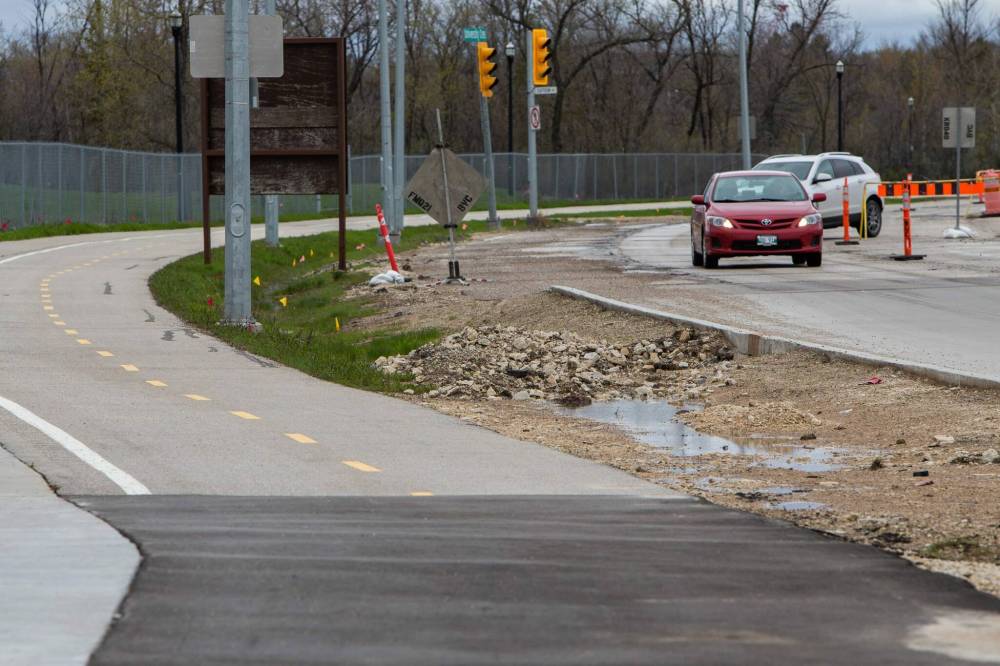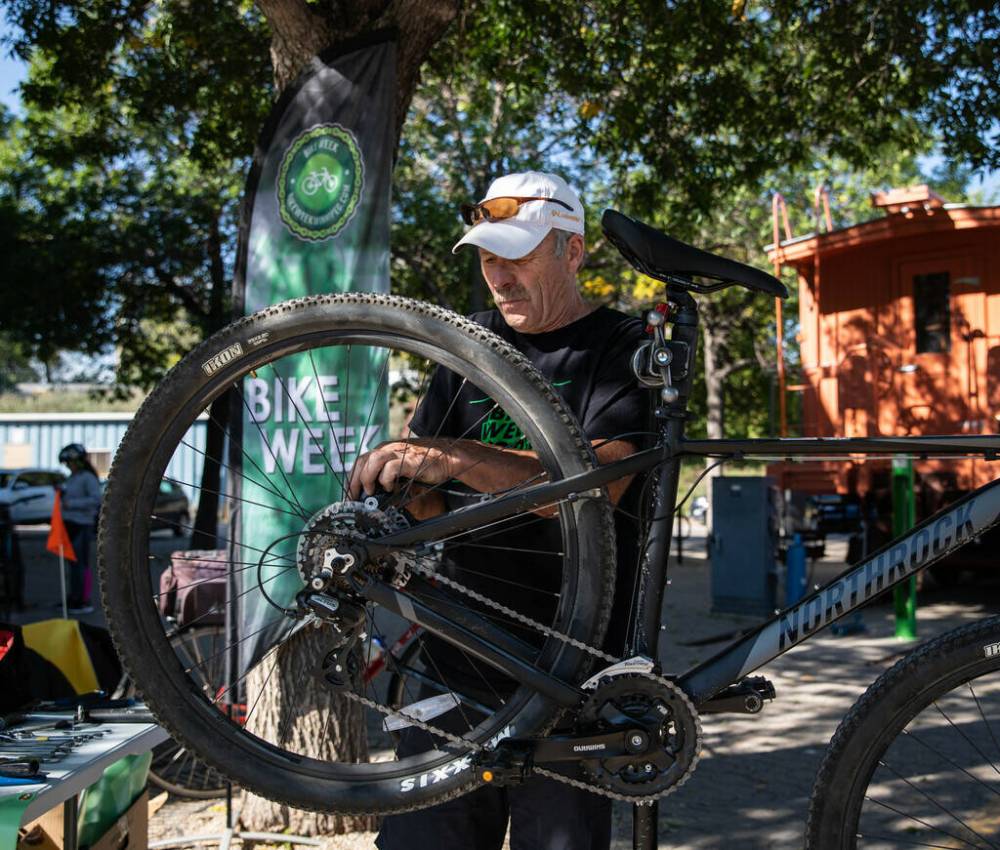Missing: active pathways, millions to pay for them Frustrated city councillor can’t get answers from public service on approved, paid-for bike, walking lanes that didn’t appear when roads rebuilt
Read this article for free:
or
Already have an account? Log in here »
To continue reading, please subscribe:
Monthly Digital Subscription
$0 for the first 4 weeks*
- Enjoy unlimited reading on winnipegfreepress.com
- Read the E-Edition, our digital replica newspaper
- Access News Break, our award-winning app
- Play interactive puzzles
*No charge for 4 weeks then price increases to the regular rate of $19.00 plus GST every four weeks. Offer available to new and qualified returning subscribers only. Cancel any time.
Monthly Digital Subscription
$4.75/week*
- Enjoy unlimited reading on winnipegfreepress.com
- Read the E-Edition, our digital replica newspaper
- Access News Break, our award-winning app
- Play interactive puzzles
*Billed as $19 plus GST every four weeks. Cancel any time.
To continue reading, please subscribe:
Add Free Press access to your Brandon Sun subscription for only an additional
$1 for the first 4 weeks*
*Your next subscription payment will increase by $1.00 and you will be charged $16.99 plus GST for four weeks. After four weeks, your payment will increase to $23.99 plus GST every four weeks.
Read unlimited articles for free today:
or
Already have an account? Log in here »
Hey there, time traveller!
This article was published 20/05/2022 (1297 days ago), so information in it may no longer be current.
On paper, it seems like a pair of simple projects that could easily be done to move Winnipeg’s active transportation agenda forward.
But like most things in the city, what is budgeted and what actually happens are two different things.
In the case of the bike-lane and multi-use path projects, the cost of which total $2.2 million and were supposed to be completed last year, no one can clearly explain why the work wasn’t done. Or where the money went.
The University Crescent road reconstruction project was launched with Phase 1 of construction beginning in 2021 and Phase 2 scheduled for this year.
City council approved $9.9 million for the project, including $900,000 for a protected bike lane in the first phase, and $1.2 million for active transportation infrastructure in the second.
But there was no bike lane when last year’s construction was completed.

The council-approved 2015 pedestrian and cycling strategy identified the location (near the University of Manitoba) as one of the highest priorities in the city for active transportation infrastructure.
Coun. Matt Allard, who chairs the public works committee, said he’s repeatedly asked that department and chief administrative officer Michael Jack what happened on the project and why the bike lane wasn’t built — to no avail.
“I’m concerned. I’m frustrated. I’m waiting for answers,” said Allard (St. Boniface). “I’ve had multiple meetings with staff from the public works department. I’ve had a meeting with the CAO. I’ve requested a subsequent meeting with the CAO.

“There is a lot of uncertainty in terms of what is going on, as it pertains to approved budgets, council policies and what has happened on the ground.”
The city refused a Free Press request for an interview with staff about the University Crescent project. Instead, Ken Allen, communications co-ordinator for the public works department, sent a written statement.
“The project is ongoing and certain sections have been completed. Work on completing the entire active transportation pathway is contingent on finalizing land acquisition and addressing land drainage issues,” Allen wrote.
But he did not address the request for details on why the protected bike lane wasn’t built and what happened to the $900,000 set aside for its construction.
Allard said the University Crescent project is not a one-off.

The city’s budget set aside $1.3 million for a multi-use path on Keewatin Street near the Logan Avenue underpass, to be completed last summer as part of a road rehabilitation project.
The path wasn’t built, and it’s not clear where the money went.
In his written statement, Allen said the $1.3 million earmarked for the path had been “erroneously identified” in both the 2021 capital budget and the 2015 pedestrian and cycling strategy.
In other words, the city set aside $1.3 million for an active transportation project – in both its 2015 long-term strategy document and its 2021 budget – by mistake.
“With that said, a preliminary design study is underway to identify potential off-road active transportation options, including budget and scope, to connect Selkirk to Burrows. There will be no re-work required related to last year’s pavement rehabilitation,” Allen wrote.
“What’s concerning is we’ve got streets which have clearly identified, prescribed treatments for active transportation, and yet they didn’t happen. The streets got reconstructed and the active transportation isn’t there.” – Coun. Matt Allard
Allard said the issue is bigger than just the University Crescent and Keewatin Street examples. He points to a 2008 council motion and the council-approved 2015 pedestrian and cycling strategy, which state that building the city’s active transportation network will be tied to annual road work.
“It was understood at the time that we voted on this, that we would build the network incrementally. So, piece by piece, the network would be built… using the road-renewal budget, and eventually we’d have a complete active transportation network,” Allard said.
“I’ve been voting for budgets — budget after budget — with the understanding that, despite the very large, record spending on roads, in the event that roads were identified (by the 2015 strategy), that those roads would be getting active transportation treatments.”
But he pointed to at least three other cases — on Roblin Boulevard, Hargrave Street and Day Street — where that work wasn’t done.
“What’s concerning is we’ve got streets which have clearly identified, prescribed treatments for active transportation, and yet they didn’t happen. The streets got reconstructed and the active transportation isn’t there,” he said.
“And I’m concerned and I’m frustrated that despite the budgets, despite the policies in place, the public service is renewing and rehabilitating these roads without the required active transportation components.” – Coun. Matt Allard
“And I’m concerned and I’m frustrated that despite the budgets, despite the policies in place, the public service is renewing and rehabilitating these roads without the required active transportation components.”
Dave Elmore, one of the founding directors of Bike Winnipeg, said the city’s pedestrian and cycling strategy is not ambitious enough.

“We’re not seeing the kind of funding required to even meet their so-called award-winning strategy.… They’re simply not following through with the funding required to make it happen — not even close,” Elmore said.
“The city has indicated that with road renewals, active transportation will be considered. But it hasn’t always happened. And it’s been disappointing to watch.”
Allard said he has requested a report from the public works department explaining what active transportation projects are planned for this year, and what projects have not been done in the past — in contravention of the city’s 2008 and 2015 policies.
The public service was given until September to produce the report.
“If the issue is not council policy, if the issue is not council budgets, then the issue is with the public service, and the public service implementing council policy and council budgets as they are written… I have a number of outstanding questions,” he said.
“There were projects constructed with explicit dollars assigned for active transportation. It wasn’t built and I don’t know where those monies are at… In a nutshell: I feel like I didn’t get what I paid for. I didn’t get what I voted for.” – Coun. Matt Allard
“There were projects constructed with explicit dollars assigned for active transportation. It wasn’t built and I don’t know where those monies are at… In a nutshell: I feel like I didn’t get what I paid for. I didn’t get what I voted for.”
A request for comment sent to the Winnipeg Association of Public Service Officers was not responded to by deadline.
Allard said he is hopeful answers will be forthcoming in September. If not, he said an audit would be the last available avenue to get to the bottom of what’s been going on.
“Ultimately, I don’t just want answers. I want projects getting built,” he said.
“I want projects getting built for the budgets we approved and the policies we approved.”
Twitter: @rk_thorpe

Ryan Thorpe likes the pace of daily news, the feeling of a broadsheet in his hands and the stress of never-ending deadlines hanging over his head.
Our newsroom depends on a growing audience of readers to power our journalism. If you are not a paid reader, please consider becoming a subscriber.
Our newsroom depends on its audience of readers to power our journalism. Thank you for your support.








